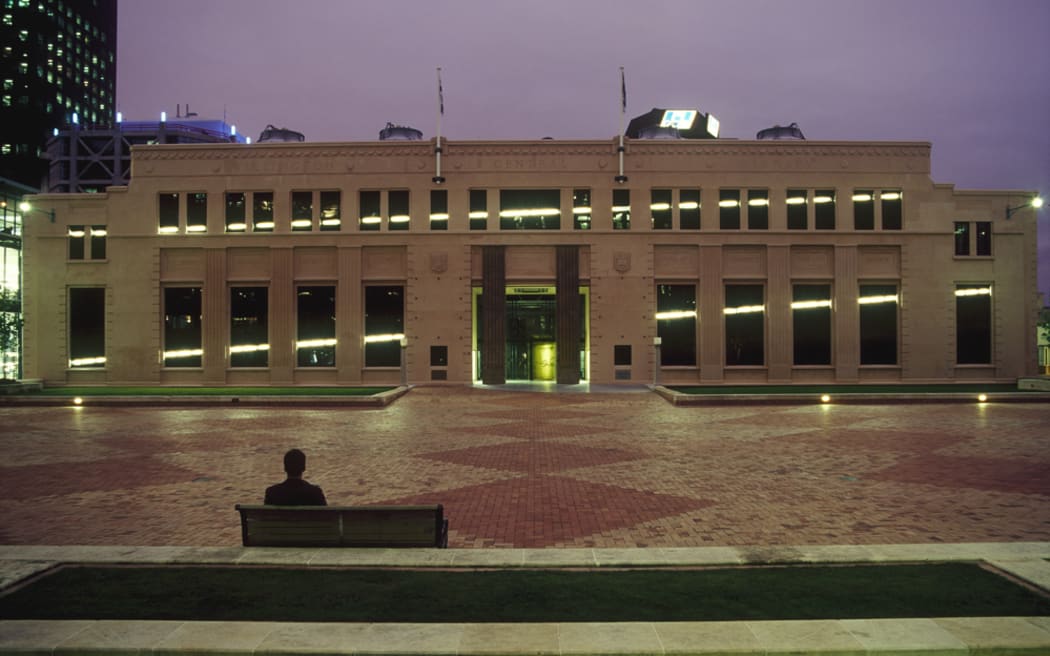
Ronnie Van Hout’s Quasi atop City Gallery Wellington
Photo: Mark Tantrum
A “lack of joined-up thinking” in Wellington’s gallery sector has led to two major art spaces closing at the same time, an art historian and former gallery director says.
Dr Christina Barton joined Mark Amery on Culture 101 on Sunday to discuss the challenges facing museums and galleries.
On Monday, institutions nationwide will turn off their external lighting as part of Keep the Lights On, a campaign from industry body Museums Aotearoa to highlight the galleries’ dire financial situation.

Christina Barton
Photo: supplied
It follows a run of bad news from Pōneke Wellington this month. City Gallery Wellington will close temporarily while building work in Te Ngakau Civic Square takes place. The top floor of Te Papa, where the national art collection is displayed, needs to close for at least nine months while a rusty sprinkler system is replaced.
Meanwhile, City Gallery Wellington is without a director at present, and the New Zealand Portrait Gallery Te Pūkenga Whakaata has warned it could close soon without extra funding.
Dowse Art Museum Lower Hutt curator and director Karl Chitham (Ngā Puhi) and independent curator and former programme implementation manager for Wellington City Council’s cultural strategy Aho Tini 2030 Dr Sophie Jerram also joined the conversation with Culture 101.
Chitham described Pōneke’s gallery sector as an “ecosystem”.
Barton, the former director of Te Pātaka Toi Adam Art Gallery, said it was one with “a lack of joined-up thinking”.

Sophie Jerram
Photo: supplied
“And that comes back to leadership. If all the institutions came together and really workshopped what the city needed, recognised the strengths of the different institutions and came up with a strategy that covered all the bases then maybe you would not perhaps have Te Papa and City Gallery closing at exactly the same time.”
Work on a new library, Te Matapihi, has already seen City Gallery limit access since December by slashing nearly 20 hours off its opening times – keeping its usual weekend hours but only opening on weekdays between 4 and 7.30pm.
The gallery may close its 1940s building in June for a period while a municipal civic building is demolished in Te Ngākau Civic Square.
On the other side of the square, significant work on a reconditioned town hall will continue until nearly 2027, and the nearby City to Sea bridge could be demolished due to earthquake strengthening issues.

Karl Chitham
Photo: supplied
But for some time, it has not been building issues that have been causing the most concern – rather, it is the tightness of budgets and the fallout of restructuring.
In 2021 Experience Wellington underwent a major restructure that saw the departure of one of the most experienced senior curators at City Gallery, Robert Leonard, and the merging of director roles across the trust’s museums.
Former City Gallery director Elizabeth Caldwell is now running the Cable Car Museum and others alongside the gallery.
There was a large outcry from the arts sector at the restructure. Previous City Gallery Foundation chair Alan Judge accused the trust of throwing the gallery under a bus, and Jenny Harper, the former director of the Christchurch Art Gallery, said it would “signal a very unfortunate end to City Gallery as we know it”.
Mayor Andy Foster acknowledged there were widespread concerns the gallery might have its ability to attract and curate exhibitions compromised. Yet the restructure proceeded.

Bill Culbert and Ralph Hotere’s Fault on the City Gallery facade in 1997
Photo: supplied
Experience Wellington now has a new chief executive, Diana Marsh, after a raft of departures from the top positions over summer, including the one left with experience of the visual arts, Elizabeth Caldwell. Recruitment for the position of manager arts and heritage has not begun.
At another nationally leading contemporary public art gallery, the Adam Art Gallery at Te Herenga Waka Victoria University, the position of director remains unfilled.
Elsewhere in New Zealand, the Christchurch Arts Centre is in a loud standoff with the Christchurch City Council and in New Plymouth, the Govett-Brewster Art Gallery and Len Lye Centre is facing a proposed restructure.
Gallery director Zara Stanhope – who has a long international career with contemporary art looking to the Asia-Pacific region – has been appointed to a new role of manager cultural experiences across institutions.
